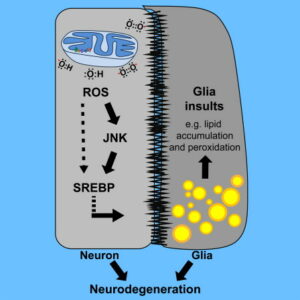We are really excited that our latest paper, in collaboration with the Bellen lab at Baylor, has been published in the prestigious journal Cell.
Our work, titled: Glial lipid droplets and ROS induced by mitochondrial defects promote neurodegeneration, has identified a conserved mechanism that leads to neuronal death after mitochondrial defects.
In this study, the Bellen lab, using the fruit fly as a model, identified that mitochondrial mutations causing reactive oxygen species (aka oxidative stress) induced the accumulation of lipid droplets in glia, the cells that surround and support neurons, via activation of a pathway known as JNK/SREBP. Lipid droplets are energy storage organelles, especially when neurons are faulty, but when these lipid droplets become peroxidated glia is unable to support neurons, leading to their demise.

Our work was key in identifying that this mechanism was present in mice, suggesting it has been evolutionary conserved, highlighting its potential importance.
Finally, we used a potent antioxidant, AD4, that crosses the blood-brain-barrier (which limits the access of many drugs to the brain), and showed that it was able to reduce and delay the onset of the disease.
We are really excited of the future therapeutic potential of this approach and we are really happy of this fruitful collaboration (pun intended!).
The article can be accessed here.